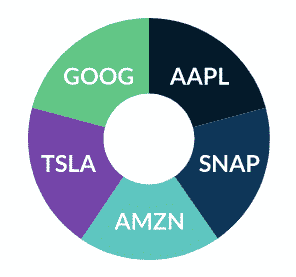
Wealthfront, which was founded in 2008, is practically a template for the types of passive portfolio services that robo-advisors represent.
The template features index exchange-traded fund (ETF), algorithmic wealth management and sophisticated techniques for optimizing after-tax returns.
M1 Finance, which was founded in 2015, provides digital wealth management too, but it also offers portfolio customization and other services that are more typically associated with full-service online brokerages, such as tastyworks or thinkorswim.
M1 Finance’s CEO Brian Barnes calls this approach “engaged investing” to differentiate it from the passive investing approach epitomized by robo-advisors like Wealthfront.
M1 Finance vs Wealthfront Features
How do Wealthfront and M1 Finance features compare?
| Wealthfront | M1 Finance | |
| Fees | 0.25% (first $10,000 free) | $0 |
| Investment Minimum | $500 | $100 (taxable account) $500 |
| Tax Strategy | Tax-loss Harvesting & Smart Beta | Tax Minimization |
| Account Selection | Extensive | Extensive |
| Tools | Extensive | Limited |
| Human Advice | No | No |
| Discretion Over Portfolio Selection | Low | High |
Wealthfront Fees
Wealthfront bills clients monthly for account management services.
This fee amounts to 0.25% of all assets held under Wealthfront management and is computed using the average monthly account balance.
If you have under $10,000, Wealthfront won’t charge you a penny in management fees.
For clients with more than $10,000 under management, Wealthfront also passes along the embedded fees associated with the ETFs in their accounts.
>> Compare Wealthfront Vs Wealthsimple
M1 Finance Fees
M1 Finance doesn’t charge any broker fees, commission fees or annual management fees.
You will have to pay the expense ratios associated with any of the ETFs in your account.
Account Types
| Wealthfront | M1 Finance |
| Personal investment accounts | Individual brokerage accounts |
| Trust accounts | Joint brokerage accounts |
| Joint accounts | Trust accounts |
| 529 college savings plans | Traditional and Roth IRAs |
| Traditional and Roth IRAs | Simplified Employee Pension (SEP) IRAs |
| Simplified Employee Pension (SEP) IRAs | IRA and 401(k) rollovers |
| IRA and 401(k) rollovers |
>> Compare Betterment Vs M1 Finance
The SV Bank collapse marked the second-largest U.S. bank to close since the Great Recession…'God have mercy on us all': Robert Kiyosaki warned.
Kiyosaki is turning to gold and silver — a popular hedge against inflation. Gold can't be printed out of thin air like fiat money and it's value is largely unaffected by economic events.
'I'm buying gold because I don't trust the Fed," he said.
source: yahoo!news
Ready to dump your paper assets? Get Your Free Gold & Silver Guide Now
Wealthfront vs M1 Finance
Tax Strategy
Wealthfront Tax Strategy
Wealthfront’s shines brightest when it comes to tax strategy.
It practices tax-loss harvesting, which is a process whereby securities that have been losing money are sold to capture a capital loss.
That loss is used to offset taxable capital gains of up to $3,000 of ordinary taxable income every year.
Wealthfront then rebalances the client’s portfolio by replacing the sold asset with one that is similar in terms of the portfolio’s overall risk-and-return profile.
Only taxable accounts are eligible for tax-loss harvesting, which is conducted daily.
For accounts with assets under management totaling $100,000 or more, Wealthfront offers tax-loss harvesting at the more granular stock level.
| WEALTHFRONT SPOTLIGHT | |
 InvestorMint Rating 4 out of 5 stars |
via Wealthfront secure site |
The early bird gets the worm and the options trader who waits until 9:30EST can win big! Hi, I'm Dave Aquino and if you're new to options trading, my e-book "How To Master the Retirement Trade" will show you exactly how to take advantage of this early morning, profitable, but often overlooked window of trading time.
Download your copy today and let's get started!
Accounts with assets under management of $500,000 or more benefit from Wealthfront’s Smart Beta function, which integrates aggressive tax-loss harvesting with intelligent weighting by considering factors like fund value, momentum and volatility.
Clients can even benefit from Wealthfront’s tax strategies while they’re still in the process of transferring their accounts from another brokerage.
Wealthfront’s Tax-Minimized Brokerage Account service deliberately delays the transfer of money-losing securities until those securities can qualify as “long-term” investments as defined by the IRS.
Once the securities mature, Wealthfront transfers them and immediately sells them.
M1 Finance Tax Strategy
M1 Finance provides a simplified form of tax-loss harvesting known as Tax Minimization.
This allocation strategy is designed to help automatically reduce the amount clients will owe in taxes when securities are sold as part of the automated rebalancing process.
Securities are sold in the following order to maximize tax efficiency:
- Positions that result in no capital gains
- Positions that will result in long-term capital gains
- Positions that will result in short-term capital gains
| M1 FINANCE SPOTLIGHT | |
InvestorMint Rating 4 out of 5 stars |
via M1 Finance secure site |
This list ranks the top stocks daily based on our proprietary algorithm. FREE Bonus: 3 Stocks To Double This Year
View this list for FREE now!
➤ Free Guide: 5 Ways To Automate Your Retirement
Human Advice vs Digital Advice
Neither Wealthfront nor M1 Finance gives clients access to human advisory services.
However, M1 Finance will allow you to book a no-cost consultation with a product specialist after you fund your account.
You will be given a brief tour of the online platform and any technical questions you may have will be answered.
Tools and Calculators
M1 Finance Tools
While M1 Finance doesn’t have calculators, widgets or other bells and whistles per se, the highly graphic nature of the user interface makes it very easy to grasp how your investment styles are reflected in the investment options you’ve selected.

When you’re putting together a portfolio, you have the option of selecting among professionally assembled M1 Finance pies, which represent various types of investment strategies, including hedge fund strategies and responsible investment strategies.
Other pies represent individual industries or industry sectors.
Clients can also customize their own pies using any combination of stocks and ETFs listed on the New York Stock Exchange or NASDAQ.
To customize a pie, just input criteria like:
- Company name
- Total assets
- Dividend yield
- Expense ratio
- P/E ratio
Keep in mind, however, that you cannot hold more than 500 individual positions in your pies.
Although you have to have an account with M1 Finance before you can use the pie feature, you can create and customize your M1 Finance pies without funding that account.
>> Compare M1 Finance Vs Robinhood
Wealthfront Tools
Wealthfront clients have free access to a tool called Path.
Path is a future-scenario planning algorithm that combines information from the financial accounts you’ve linked to your Wealthfront account with economic criteria from the Bureau of Labor Statistics’ Consumer Expenditure Surveys.
Path uses this data to create a series of alternate outcomes that are influenced by changes you implement in your portfolio allocations.
Wealthfront designed Path to help clients model investment forecasts and see how much they will need to save by a specific date if they want to achieve their financial goals.
Biden's disturbing new government program may be worse than Obama's. You are at risk for having your bank account frozen. A former bank regulator is blowing the whistle on Biden's frightening plan to take over your money.
Discover the immediate steps you need to take now.
M1 Finance vs Wealthfront
Asset Classes
Wealthfront Asset Classes
When you sign up for Wealthfront, the robo-advisor compiles your portfolio for you.
The criteria the algorithm uses reflect your risk tolerance, your expectation of return and your financial goals, which will be apparent from the interview questions you were asked to answer as part of your application process.
All clients are assigned to one of three separate portfolio classes:
| Stocks | Bonds | |
| Balanced Portfolio | 50% | 50% |
| Growth Portfolio | 80% | 20% |
| Conservative Portfolio | 65% | 35% |
Wealthfront’s robo-advisor algorithm uses an economic framework called Modern Portfolio Theory to create client portfolios and to maintain the balance within those portfolios over time.
Each individual portfolio contains between six and eight ETFs, which represent bonds, inflation-protected securities and stocks.
M1 Finance Asset Classes
If you can buy a stock on the New York Stock Exchange, you can use it to create a portfolio with M1 Finance.
The service also gives you access to more than 1,900 ETFs.
However, if you’re not interested in customizing a portfolio, you can use one of M1 Finance’s preset portfolios called “expert pies.”
It is also easy to substitute your own choices for some of the stocks and ETFs in an M1 Finance template.
The robo-advisor component of the company’s services goes into play when it comes to ongoing investing.
You can designate a time frame for bank-account funding contributions, and M1 Finance will withdraw those funds automatically and invest them in accordance with the template you’ve created.
M1 Finance also allows you to buy fractional shares when you don’t have the funds to buy a whole share.
Plus, M1 Finance’s algorithm rebalances your portfolio if your investments begin to fluctuate in market value.
When selling securities to rebalance a portfolio, M1 Finance uses a tax-minimization strategy.
Additionally, M1 Finance allows clients to buy stocks on margin through a feature called M1 Borrow.
If you were wondering how does M1 Finance make money, this is in fact how the company generates revenues from its services.
M1 Finance charges 4% interest on the total amount borrowed. The borrowed amount can never exceed 35% of the total account balance, though.
M1 Finance is only available to account holders with $10,000 or more under management.
Customer Support Comparison
For customers experiencing technical issues, M1 Finance offers phone support Monday through Friday from 9 a.m. to 5 p.m. CST.
Wealthfront also offers a customer hotline that is available Monday through Friday from 11 a.m. to 8 p.m. EST.
>> Compare Wealthfront Vs Personal Capital
Mobile App Comparison
M1 Finance is available as a mobile app for both iOS and Android devices.
The user-friendly phone app has the same functionality as the PC platform.
Wealthfront iOS and Android apps also allow clients to do everything possible on a laptop or desktop computer.
Wealthfront vs M1 Finance
Winner
M1 Finance excels when it comes to customizing investment selections.
And it shines brightest on price, you can’t beat free!
However, the tax strategies the service offers clients can’t rival the tax strategies Wealthfront offers.
M1 Finance also lacks a robust financial planning tool.
Still, if price and portfolio customization is what’s most important to you, M1 Finance is the obvious winner.
Of course, you might argue that asset allocation is actually one of the services you’re looking for with any type of advisory account whether your advisor is a human being or an algorithm.
With M1 Finance, you won’t be able to live out your day-trading fantasies because the service only does batch trades once a day.
To use M1 effectively, you’ll have to educate yourself on financial matters and discipline yourself in terms of what you buy.
>> Compare Betterment Vs Wealthfront
Which Robo-Advisor
Is Best For You?
M1 Finance is the best choice if you want to:
- Trade stocks and ETFs without paying commission fees or annual management fees.
- Be able to buy fractional stock shares.
- Customize the stocks and ETFs in your investment portfolio.
Wealthfront is the best choice if you want to:
- Protect your investments against tax liabilities.
- Save efficiently for your son or daughter’s college education.
- Invest passively and don’t wish to exercise a lot of control over your specific investment choices.
We could be facing one of the harshest economic challenges ever experienced thanks to an incompetent government and severe global unrest. If you aren't proactive, you could see yourself and your family become another financial casualty. But, the Inflation Survival Plan has you covered. Learn insider tips and tricks, IRS loopholes and more that will help your finances soar.
Take 15 Seconds to get the FREE Inflation Survival Plan and ensure your family's financial security.









